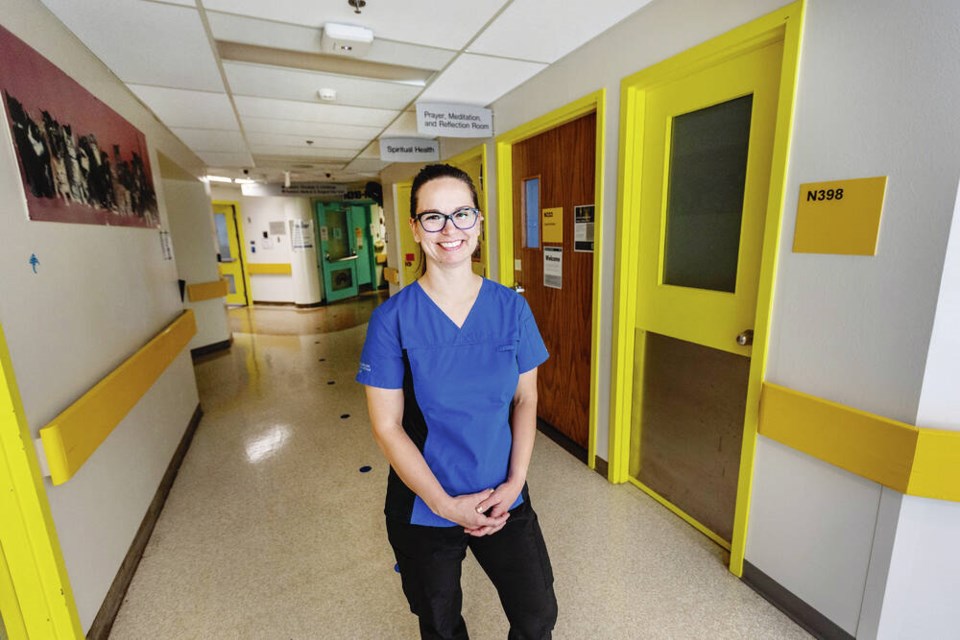Camosun College’s nursing program is traditionally flooded with applicants and has a wait list, but this fall, 18 training seats are vacant and there’s been a dramatic drop in people submitting their resumés.
The college suspects a number of factors are at play, with some applicants from outside south Vancouver Island citing the challenge of finding affordable — or any — accommodation.
Selina Robinson, minister of post-secondary education and future skills, said she’s been hearing a similar story in other parts of the province this month. “We’re going to be analyzing that going forward.”
Preliminary information suggests that aside from cost barriers, the challenges nurses experienced during the pandemic might have dissuaded some applicants, said Robinson. Some left the profession amid labour shortages, overtime pressures and pushback from the anti-vaccination movement.
“It’s been portrayed as a really tough gig,” said Robinson. “We’re looking to address how do we help people feel like this is a good profession that has longevity and where they’re supported.”
Another problem is that when jobs are plentiful, fewer people tend to seek post-secondary education, she said — which is one reason why the province is looking at ways people can upgrade without leaving the workplace.
It’s typical to see 600 applications for 160 seats for the joint Camosun College/University of Victoria bachelor of nursing program, which offers clinical experience and turns out practice-ready nurses after four years.
But this year, only 142 of 160 seats were filled, said Kristin McLaughlin, chair of the nursing program at Camosun.
“So we’re down considerably,” she said, adding the vacant seats will be filled by January with qualified students who took maternity breaks or other temporary leaves of absence, so the college still expects to graduate 160 nursing students in four years.
McLaughlin said nurses are well compensated in B.C. and it remains a “very attractive undergraduate program.” Figuring out why applications have dropped requires a “deeper dive” into everything from incentives to demographic shifts, she said.
“I think definitely we need to look at what’s going on in admissions, what does it look like across the rest of the province, and also across the rest of the country,” said McLaughlin. “But also there are some structural pieces here that I think are beyond the scope of post-secondary to address, including, predominantly, housing.”
McLaughlin said right up until the first week of classes, the department was hearing from students who had been accepted to the program saying they couldn’t find a place to live.
Christina Tsuil-menak, 43, is in her third year of the program and said the year she started, there were almost 1,000 applications. “I find that shocking that just after two years they can’t even fill the seats,” she said Tuesday.
Tsuil-menak, an Indigenous member of the Secwépemc people who is originally from Cache Creek, said the profession offers many options, whether in research, teaching, working in hospitals, public health or community health.
“You’re always learning and that to me is amazing,” she said. “And it’s not necessarily from textbooks — it’s from patients, it’s from your colleagues and other nurses and your peers.”
Tsuil-menak, who started out as a licensed practical nurse prior to having kids, said the more she explores the various avenues in nursing, the more areas she finds herself interested in. Right now, the mother of two children age 12 and 17 is focused on maternity care.
“I just love nursing,” said Tsuil-menak. “I love working with people, and patients and their family especially in a health-care setting.”
Prior to signing up for the Camosun program, Tsuil-menak worked as a care aide in the community, but when her elderly clients — who encouraged her to further her education — eventually died, she decided to train as a registered nurse.
During the summer, she works as what’s called an employed student nurse. “It’s such a rewarding career, I would hope people would at least attend an information session to see what a gift nursing is … to experience the joy of becoming a nurse,” she said.
B.C. Nurses Union president Adriane Gear suspects the cost of living, a hot labour market and an already heavy workload that intensified during COVID are all contributing factors to unfilled student seats, although she’s not sure if it’s a “one-off this year” or a trend.
While nursing pays relatively well, people may be choosing other careers with even better earning potential, Gear said, adding beyond bursaries, there are few incentives for nursing students to offset the costs of the four-year program, housing and child-care.
It’s a concern because there are at least 5,000 unfilled nursing jobs in the province and a national nursing shortage, she said.
The BCNU is calling on the province and health authorities to incentivize and support people going into the profession “so that it’s seen as a desirable option for young men and women” and to encourage those who have left nursing to return.
“Incentivizing students in terms of tuition costs and loan forgiveness would go a long way,” said Gear.
In the 2021 provincial budget, $96 million over three years was earmarked to support training for health-sector workers, including 602 new seats in nursing, on top of the approximately 2,000 existing seats in nursing programs at public post-secondary institutions.
>>> To comment on this article, write a letter to the editor: [email protected]



